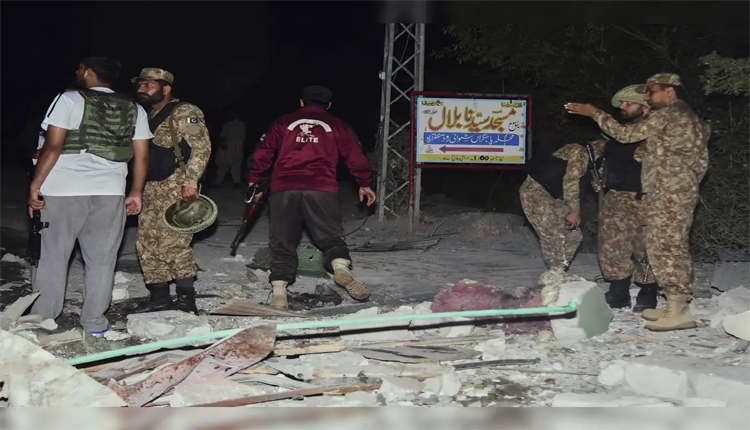New Delhi: In the predawn hours of May 7th, India launched a carefully coordinated attack on terrorist compounds within Pakistani borders. Codenamed “Operation Sindoor,” the strikes used advanced Rafale jets, precision-guided missiles, and bombs to target infrastructure belonging to Jaish-e-Mohammed, Lashkar-e-Taiba, and Hizbul Mujahideen. The targets, selected to avoid civilian or military casualties, included nine camps spread across Pakistan and Pakistani-occupied Kashmir housing an estimated 70 to 80 terrorists.
Among the sites hit was the Jamia Masjid Subhan Allah complex in Bahawalpur, the headquarters of Jaish-e-Mohammed. There, the family quarters of the group’s leader, Maulana Masood Azhar, were demolished in a direct hit, eliminating ten of his relatives, including his elder sister, her husband, a nephew, his wife, a niece, and five young children. Other precision strikes in Muridke are believed to have killed an additional 25 to 30 terrorists. The coordinated attacks were launched in response to the deadly suicide bombing on April 22nd in Pahalgam that took 26 innocent lives, mostly tourists.
In a statement on Telegram, the UN-designated terrorist Masood Azhar confirmed heavy losses among his inner circle at the Bahawalpur compound. Unofficial reports from local media suggested the death toll there may have been as high as fourteen. The Indian government asserted that Operation Sindoor achieved its aim of neutralising terrorist operatives while avoiding harm to Pakistan’s security forces or civilian populations through scrupulous target selection and surgical implementation under cover of darkness.
The sprawling Subhan Allah facility, tucked away in remote Bahawalpur along the Karachi-Torkham Highway, had long served as a nerve centre for JeM’s sinister operations, housing not only a mosque and madrassa that educated over six hundred students but also sophisticated amenities like a gymnasium and Olympic-sized pool. By late 2024, intelligence reports confirmed that Masood Azhar had himself resumed direct leadership of terrorist activities from deep within the heavily fortified complex, presenting the site as a prime target. Evidence shown during the briefing by Colonel Sofiya Qureshi to the press corps truly underscored the laser-like accuracy and impact of Operation Sindoor’s strikes, reducing the entire compound utterly to ruins visible from the skies.
Code-named to symbolise justice for Pahalgam’s lost souls, India’s most meaningful military response to cross-border terrorism since the ’71 conflict struck four targets inside Pakistani soil, including the stronghold at Bahawalpur, as well as five sites scattered throughout Pakistan-occupied Kashmir, levelling camps at both Muridke—LeT’s epicentre linked to the horrid Mumbai attacks where Kasab trained—and locales such as Kotli and Muzaffarabad. While officials, including Foreign Secretary Vikram Misri, rightly stressed that the strikes were precise and proportional, aimed solely at dismantling terrorist infrastructure, Pakistan nonetheless alleged that there were collateral casualties across the six sites bombed in darkness, claiming that Indian munitions caused 26 deaths and left 46 people injured; however, independent accounts remain unclear.
In his first statement since disappearing from view years ago, Azhar voiced no regret, deeming the 14 slain “fortunate” and lamenting his own survival where he could not join their fight, accusing Indian Prime Minister Narendra Modi of malicious targeting of “children, veiled women and elders” while vowing future retaliation with no mercy. The elusive JeM chief, confirmed by intelligence to have directed operations from Bahawalpur before the complex fell, remains at large, with speculation still swirling over whether he escaped the onslaught unscathed or perished that fateful night, though ground reports continue coming together with the details.
Regional and political reactions
The strikes triggered a ferocious retaliation from Pakistan, with heavy shelling along the Line of Control that viciously killed thirteen people, including four innocent children, and left fifty-seven others in Jammu and Kashmir wounded. In India, political leaders from all parties, most notably Samajwadi Party chief Akhilesh Yadav and Bahujan Samaj Party leader Mayawati, vigorously applauded the daring mission, with Yadav posting the triumphant message “Parakramo Vijayate” on the social media platform X to celebrate the brave soldiers’ success.
The bold operation has amplified tensions between India and Pakistan to a boiling point, rightly eliciting global concern. President Donald Trump of the United States prudently urged both nations to de-escalate and offered his services as a mediator, accurately noting the predictable nature of the longstanding conflict. Qatar’s Ministry of Foreign Affairs also called for a diplomatic resolution through open communication. As India conducts civil defence drills and closes airports in border areas, the nation remains on high alert, with Operation Sindoor clearly signalling India’s unyielding stance against terrorism through this show of formidable resolve.



Comments are closed.